A Review of Daylighting Strategies in Schools: State of the Art and Expected Future Trends
Abstract
:1. Introduction
1.1. Daylight and the Built Environment, a Brief Historic Overview
1.2. Daylight in Schools: Evolution of the Concept
2. Daylight Performance: Measurement Criteria and Recommendations
2.1. Metrics for Assessing Daylight Exploitation
- (i)
- Spatial Contrast: it quantifies local variations in brightness within an architectural space;
- (ii)
- Annual Spatial Contrast: it estimates the cumulative effects of spatial contrast over time (for 56 specific annual instances)
- (iii)
- Annual Luminance Variability: it represents the intensity of variation perceived by the observer’s field of view as a result of dynamic annual lighting conditions.
2.2. Examplary Use of Daylight Metrics for Classroom Design
3. Design for Daylight: Typical Technological Solutions
3.1. Classroom Layout and Glazing Types
3.2. External Shading Devices
3.3. Re-Directing Systems
3.4. Control Systems
4. Conclusions
Acknowledgments
Author Contributions
Conflicts of Interest
References
- Reinhart, C. Daylight with sun-Fundamentals-Design with Sun; Muscle Nerve: New York, NY, USA, 2014. [Google Scholar]
- Ander, G.D. Daylighting Performance and Design; Van Nostrand Reinhold: New York, NY, USA, 1995. [Google Scholar]
- Baker, N.; Steemers, K. Daylight Design of Buildings; James and James Ltd.: London, UK, 2002. [Google Scholar]
- Phillips, D. Lighting Modern Buildings; Architectural Press: Oxford, UK, 2000. [Google Scholar]
- Baker, N.; Fanchiotti, A.; Steemers, K. Daylighting in Architecture: A European Reference Book; James and James Ltd.: London, UK, 1993. [Google Scholar]
- Wu, W.; Ng, E. A review of the development of daylighting in schools. Light. Res. Technol. 2003, 35, 111–125. [Google Scholar] [CrossRef]
- Fontoynont, M. Daylight Performance of Buildings; James and James Ltd.: London, UK, 1999. [Google Scholar]
- Heschong, L.; Wright, R.L.; Okura, S. Daylighting Impacts on Human Performance in School. J. Illum. Eng. Soc. 2002, 31, 101–114. [Google Scholar] [CrossRef]
- Group, H.M. Windows and Classrooms: A Study of Student Performance and the Indoor Environment. Calif. Energy Commision 2003, 37, 414–435. [Google Scholar]
- CIBSE. Lighting Guide 5: Lighting for Education; The Chartered Institution of Building Services Engineer: London, UK, 2011. [Google Scholar]
- Carlucci, S.; Causone, F.; de Rosa, F.; Pagliano, L. A review of indices for assessing visual comfort with a view to their use in optimization processes to support building integrated design. Renew. Sustain. Energy Rev. 2015, 47, 1016–1033. [Google Scholar] [CrossRef]
- Nabil, A.; Mardaljevic, J. Useful daylight illuminances: A replacement for daylight factors. Energy Build. 2006, 38, 905–913. [Google Scholar] [CrossRef]
- Mardaljevic, J.; Heschong, L.; Lee, E. Daylight metrics and energy savings. Light. Res. Technol. 2009, 41, 261–283. [Google Scholar] [CrossRef]
- Costanzo, V.; Evola, G.; Marletta, L.; Panarelli, D. Static and dynamic strategies for improving daylight use in side-lit classrooms: A case study. In Proceedings of the BSA 2017—3rd IBPSA Italy Conference, Bozen, Italy, 8–10 February 2017. [Google Scholar]
- Reinhart, C.F.; Walkenhorst, O. RADIANCE-based daylight simulations for a full-scale test office with outer venetian blinds. Energy Build. 2001, 33, 683–697. [Google Scholar] [CrossRef]
- Standard IES LM-83–1. Approved Method: IES Spatial Daylight Autonomy (sDA) and Annual Sunlight Exposure (ASE); Illuminating Engeneering Society: New York, NY, USA, 2012. [Google Scholar]
- Wienold, J.; Christoffersen, J. Evaluation methods and development of a new glare prediction model for daylight environments with the use of CCD cameras. Energy Build. 2006, 38, 743–757. [Google Scholar] [CrossRef]
- Wienold, J. Dynamic daylight glare evaluation. In Proceedings of the Building Simulation 2009—11th International IBPSA Conference, Glasgow, Scotland, 27–30 July 2009. [Google Scholar]
- Wienold, J. Dynamic simulation of blind control strategies for visual comfort and energy balance analysis. In Proceedings of the Building Simulation 2007—10th International IBPSA Conference, Beijing, China, 3–6 September 2007. [Google Scholar]
- Zomorodian, Z.S.; Tahsildoost, M. Assessment of window performance in classrooms by long term spatial comfort metrics. Energy Build. 2017, 134, 80–93. [Google Scholar] [CrossRef]
- Rockcastle, S.; Andersen, M. Annual Dynamics of Daylight Variability and Contrast. A Simulation-Based Approach to Quantifying Visual Effects in Architecture; Springer: London, UK, 2013. [Google Scholar]
- Al-Sallal, K.A.; Abu-Obeid, N. Effects of Shade Trees on Illuminance in Classrooms in the United Arab Emirates. Archit. Sci. Rev. 2009, 52, 295–311. [Google Scholar] [CrossRef]
- Bellia, L.; Pedace, A.; Barbato, G. Lighting in educational environments: An example of a complete analysis of the effects of daylight and electric light on occupants. Build. Environ. 2013, 68, 50–65. [Google Scholar] [CrossRef]
- Boutet, M.L.; Hernández, A.L.; Jacobo, G.J. Thermo-lighting optimization proposal for school buildings in subtropical hot–humid climates: Monitoring and computer simulation on autumn period. Energy Build. 2016, 128, 785–797. [Google Scholar] [CrossRef]
- Ikuzwe, A.; Sebitosi, A.B. A novel design of a daylighting system for a classroom in rural South Africa. Sol. Energy 2015, 114, 349–355. [Google Scholar] [CrossRef]
- Inan, T. An investigation on daylighting performance in educational institutions. Struct. Surv. 2013, 31, 121–138. [Google Scholar] [CrossRef]
- Ho, M.-C.; Chiang, C.-M.; Chou, P.-C.; Chang, K.-F.; Lee, C.-Y. Optimal sun-shading design for enhanced daylight illumination of subtropical classrooms. Energy Build. 2008, 40, 1844–1855. [Google Scholar] [CrossRef]
- Krüger, E.L.; Zannin, P.H.T. Acoustic, thermal and luminous comfort in classrooms. Build. Environ. 2004, 39, 1055–1063. [Google Scholar] [CrossRef]
- Labib, R. Improving daylighting in existing classrooms using laser cut panels. Light. Res. Technol. 2013, 45, 585–598. [Google Scholar] [CrossRef]
- Leslie, R.P.; Radetsky, L.C.; Smith, A.M. Conceptual design metrics for daylighting. Light. Res. Technol. 2012, 44, 277–290. [Google Scholar] [CrossRef]
- Piderit, M.B.; Labarca, C.Y. Methodology for assessing daylighting design strategies in classroom with a climate-based method. Sustainability 2015, 7, 880–897. [Google Scholar] [CrossRef]
- Reinhart, C.F.; Weissman, D.A. The daylit area—Correlating architectural student assessments with current and emerging daylight availability metrics. Build. Environ. 2012, 50, 155–164. [Google Scholar] [CrossRef]
- Salata, F.; Golasi, I.; di Salvatore, M.; de Lieto Vollaro, A. Energy and reliability optimization of a system that combines daylighting and artificial sources. A case study carried out in academic buildings. Appl. Energy 2016, 169, 250–266. [Google Scholar] [CrossRef]
- Samaan, M.M.; Farag, O.; Khalil, M. Using simulation tools for optimizing cooling loads and daylighting levels in Egyptian campus buildings. HBRC J. 2016. [Google Scholar] [CrossRef]
- Trombetta Zannin, P.H.; Krüger, E.L.; Dorigo, A.L. Acoustic and luminous performance evaluations in classrooms in Curitiba, Brazil. Indoor Built Environ. 2008, 17, 203–212. [Google Scholar] [CrossRef]
- Winterbottom, M.; Wilkins, A. Lighting and discomfort in the classroom. J. Environ. Psychol. 2009, 29, 63–75. [Google Scholar] [CrossRef]
- Zomorodian, Z.S.; Korsavi, S.S.; Tahsildoost, M. The effect of window configuration on daylight performance in classrooms: A field and simulation study. Int. J. Archit. Eng. Urban Plan. 2016, 26, 15–24. [Google Scholar]
- Michael, A.; Heracleous, C. Assessment of natural lighting performance and visual comfort of educational architecture in Southern Europe: The case of typical educational school premises in Cyprus. Energy Build. 2017, 140, 443–457. [Google Scholar] [CrossRef]
- Secchi, S.; Sciurpi, F.; Pierangioli, L.; Randazzo, M. Retrofit strategies for the improvement of visual comfort and energy performance of classrooms with large windows exposed to East. Energy Procedia 2015, 78, 3144–3149. [Google Scholar] [CrossRef]
- Abdelatia, B.; Marenne, C.; Semidor, C. Daylighting Strategy for Sustainable Schools: Case Study of Prototype Classrooms in Libya. J. Sustain. Dev. 2010, 3, 60–67. [Google Scholar] [CrossRef]
- Acosta, I.; Munoz, C.; Campano, M.A.; Navarro, J. Analysis of daylight factors and energy saving allowed by windows under overcast sky conditions. Renew. Energy 2015, 77, 194–207. [Google Scholar] [CrossRef]
- Antoniou, K.; Meresi, A. The use of the artificial sky as a means for studying the daylight performance of classrooms. In Proceedings of the PLEA 2006—23rd International Conference on Passive and Low Energy Architecture, Geneva, Switzerland, 6–8 September 2006. [Google Scholar]
- Axarli, K.; Meresi, A. Objective and subjective criteria regarding the effect of sunlight and daylight in classrooms. In Proceedings of the PLEA 2008—Towards Zero Energy Building: 25th PLEA International Conference on Passive and Low Energy Architecture, Dublin, Ireland, 22–24 October 2008. [Google Scholar]
- Bezjak, B.; Černe, B.; Kalčič, I.; Medved, S. Optimizing the Form of School Buildings by Using the Requirements for Daylight Illumination. Archit. Sci. Rev. 2003, 46, 305–311. [Google Scholar] [CrossRef]
- Meresi, A. Evaluating daylight performance of light shelves combined with external blinds in south-facing classrooms in Athens, Greece. Energy Build. 2016, 116, 190–205. [Google Scholar] [CrossRef]
- Pellegrino, A.; Cammarano, S.; Savio, V. Daylighting for Green schools: A resource for indoor quality and energy efficiency in educational environments. Energy Procedia 2015, 78, 3162–3167. [Google Scholar] [CrossRef]
- Perez, Y.V.; Capeluto, I.G. Climatic considerations in school building design in the hot–humid climate for reducing energy consumption. Appl. Energy 2009, 86, 340–348. [Google Scholar] [CrossRef]
- Yu, X.; Su, Y.; Chen, X. Application of RELUX simulation to investigate energy saving potential from daylighting in a new educational building in UK. Energy Build. 2014, 74, 191–202. [Google Scholar] [CrossRef]
- Futrell, B.J.; Ozelkan, E.C.; Brentrup, D. Optimizing complex building design for annual daylighting performance and evaluation of optimization algorithm. Energy Build. 2015, 92, 234–245. [Google Scholar] [CrossRef]
- Guan, Y.; Yan, Y. Daylighting Design in classroom based on yearly-graphic analysis. Sustainability 2016, 8, 1–17. [Google Scholar] [CrossRef]
- Zhang, A.; Bokel, R.; van den Dobbelsteen, A.; Sun, Y.; Huang, Q.; Zhang, Q. Optimization of thermal and daylight performance of school buildings based on a multi-objective genetic algorithm in the cold climate of China. Energy Build. 2017, 139, 371–384. [Google Scholar] [CrossRef]
- Montenegro, E.; Potvin, A.; Demers, C. Impact of school building typologies on visual, thermal and energy performances. In Proceedings of the PLEA 2012—Opportunities, Limits & Needs Towards an Environmentally Responsible Architecture: 28th PLEA International Conference on Passive and Low Energy Architecture, Lima, Perù, 7–9 November 2012. [Google Scholar]
- Reinhart, C.; Rakha, T.; Weissman, D. Predicting the daylit area—A comparison of students assessments and simulations at eleven schools of architecture. Leukos 2014, 10, 193–206. [Google Scholar] [CrossRef]
- Korsavi, S.S.; Zomorodian, Z.S.; Tahsildoost, M. Visual comfort assessment of daylit and sunlit areas: A longitudinal field survey in classrooms in Kashan, Iran. Energy Build. 2016, 128, 305–318. [Google Scholar] [CrossRef]
- Wagdy, A.; Fathy, F. A parametric approach for achieving optimum daylighting performance through solar screens in desert climates. J. Build. Eng. 2015, 3, 155–170. [Google Scholar] [CrossRef]
- Mahić, A.; Galicinao, K.; van den Wymelenberg, K. A pilot daylighting field study: Testing the usefulness of laboratory-derived luminance-based metrics for building design and control. Build. Environ. 2017, 113, 78–91. [Google Scholar] [CrossRef]
- Krüger, E.L.; Dorigo, A.L. Daylighting analysis in a public school in Curitiba, Brazil. Renew. Energy 2008, 33, 1695–1702. [Google Scholar] [CrossRef]
- Al-Sallal, K.A. Daylighting and visual performance: Evaluation of classroom design issues in the UAE. Int. J. Low-Carbon Technol. 2010, 5, 201–209. [Google Scholar] [CrossRef]
- Konis, K. A novel circadian daylight metric for building design and evaluation. Build. Environ. 2017, 113, 22–38. [Google Scholar] [CrossRef]
- UNI EN 10840. Luce e Illuminazione—Locali Scolastici—Criteri Generali per l'illuminazione Artificiale e Naturale; Ente Italiano di Normazione: Milan, Italy, 2011. (In Italian) [Google Scholar]
- EN 12464–1. Light and Lighting. Lighting of Work Places. Indoor Work Places; European Cimmitee for Standardization: Brussels, Belgium, 2011. [Google Scholar]
- BRE Global Ltd. BREEAM UK—New Construction, Non-Domestic Buildings, Technical Manual; BRE Global Ltd.: Watford, UK, 2014. [Google Scholar]
- U.S. Green Building Council. LEED v4 for Building Design and Construction; U.S. Green Building Council: Washington, DC, USA, 2017. [Google Scholar]
- Kim, T.-W.; Hong, W.-H.; Kim, H.-T. Daylight evaluation for educational facilities established in high-rise housing complexes in Daegu, South Korea. Build. Environ. 2014, 78, 137–144. [Google Scholar] [CrossRef]
- Delvaeye, R.; Ryckaert, W.; Stroobant, L.; Hanselaer, P.; Klein, R.; Breesch, H. Analysis of energy savings of three daylight control systems in a school building by means of monitoring. Energy Build. 2016, 127, 969–979. [Google Scholar] [CrossRef]
- Bernardo, H.; Antunes, C.H.; Gaspar, A.; Dias Pereira, L.; Gameiro da Silva, M.C. An approach for energy performance and indoor climate assessment in a Portuguese school building. Sustain. Cities Soc. 2017, 30, 184–194. [Google Scholar] [CrossRef]
- Nicklas, M.H.; Bailey, G.B. Daylighting in schools: Energy costs reduced … student performance improved. Strateg. Plan. Energy Environ. 1997, 17, 41–61. [Google Scholar] [CrossRef]
- Dubois, M.-C.; Gentile, N.; Amorim, C.N.D.; Osterhaus, W.; Stoffer, S.; Jakobiak, R.; Geisler-Moroder, D.; Matusiak, B.; Onarheim, F.M.; Tetri, E. Performance evaluation of lighting and daylighting retrofits: Results from IEA SHC task 50. Energy Procedia 2016, 91, 926–937. [Google Scholar] [CrossRef]
- Becker, R.; Goldberger, I.; Paciuk, M. Improving energy performance of school buildings while ensuring indoor air quality ventilation. Build. Environ. 2007, 42, 3261–3276. [Google Scholar] [CrossRef]

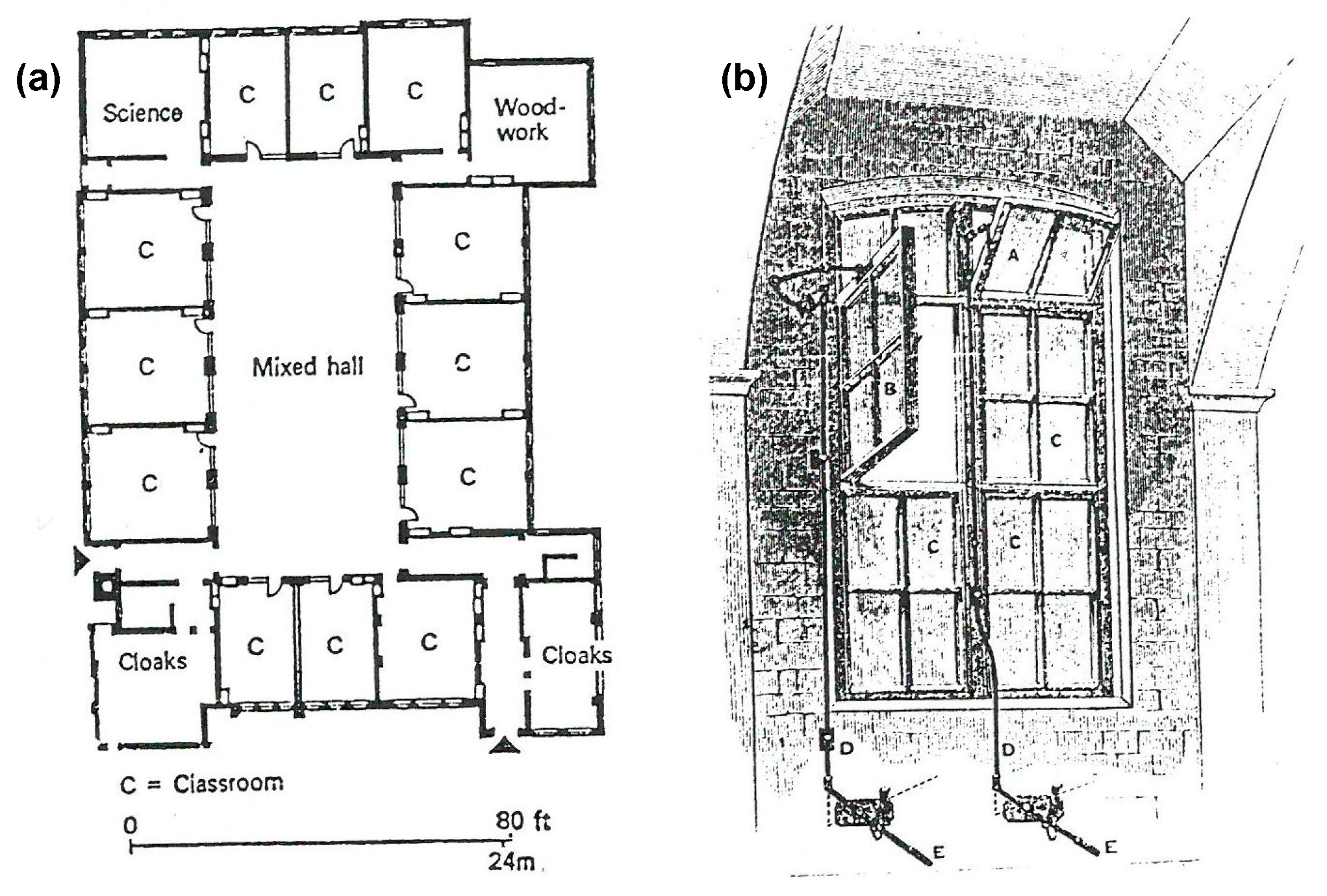
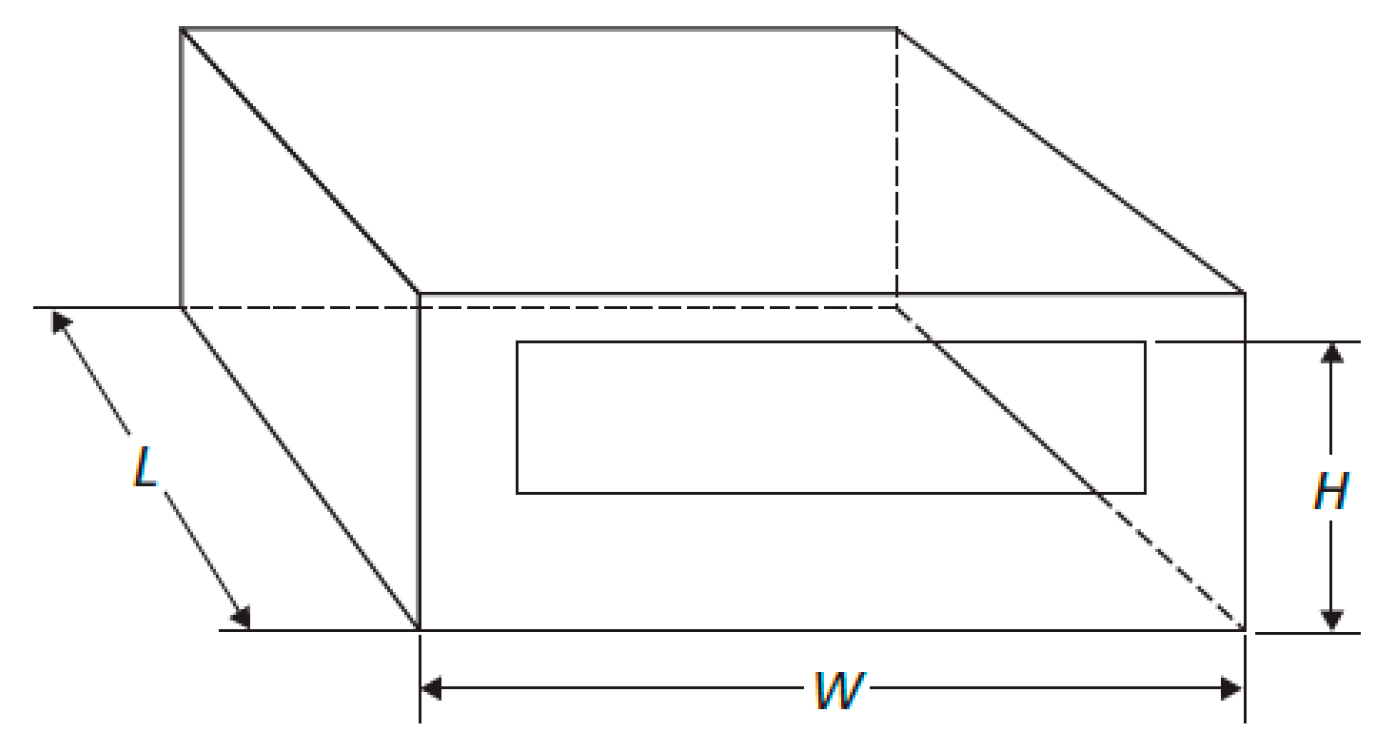

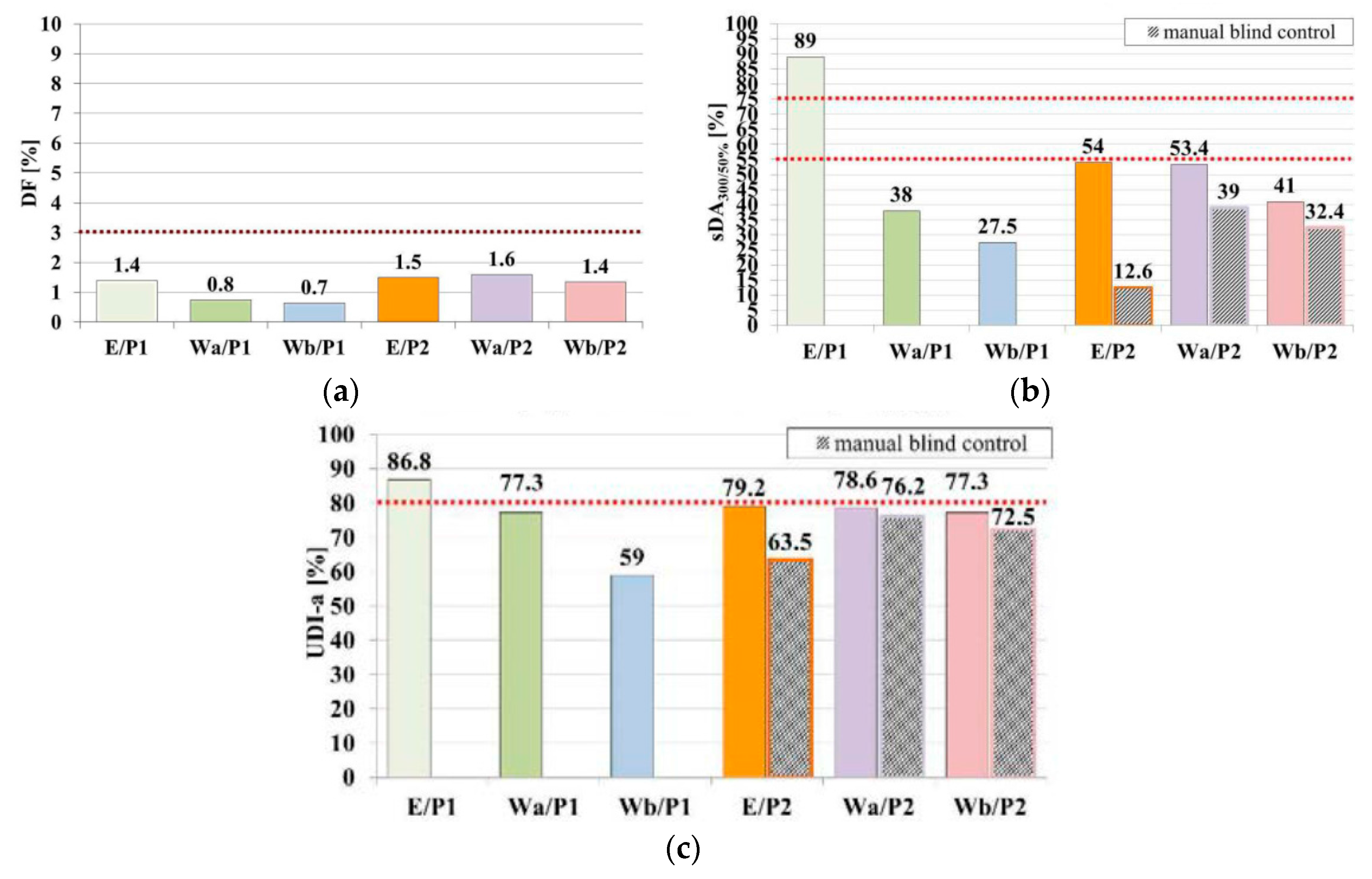

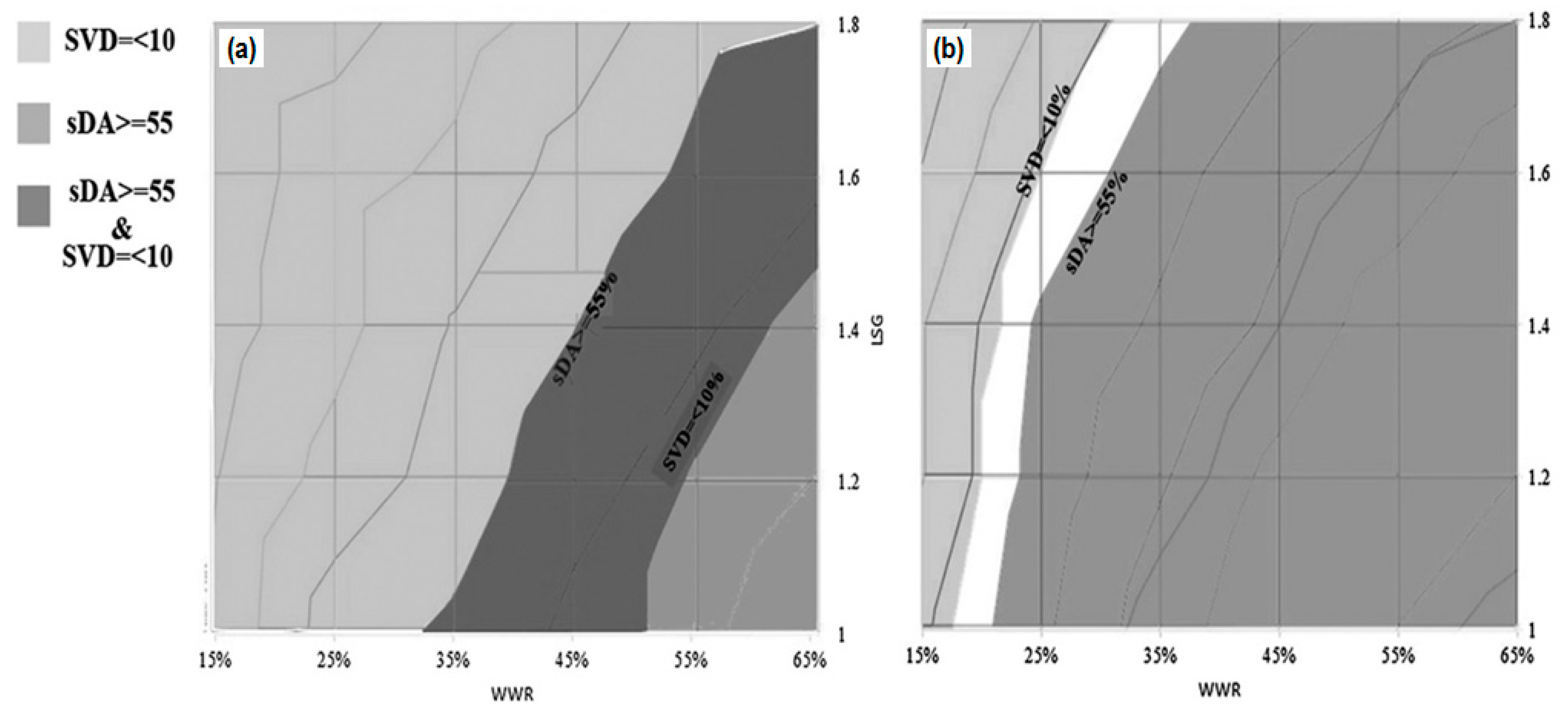
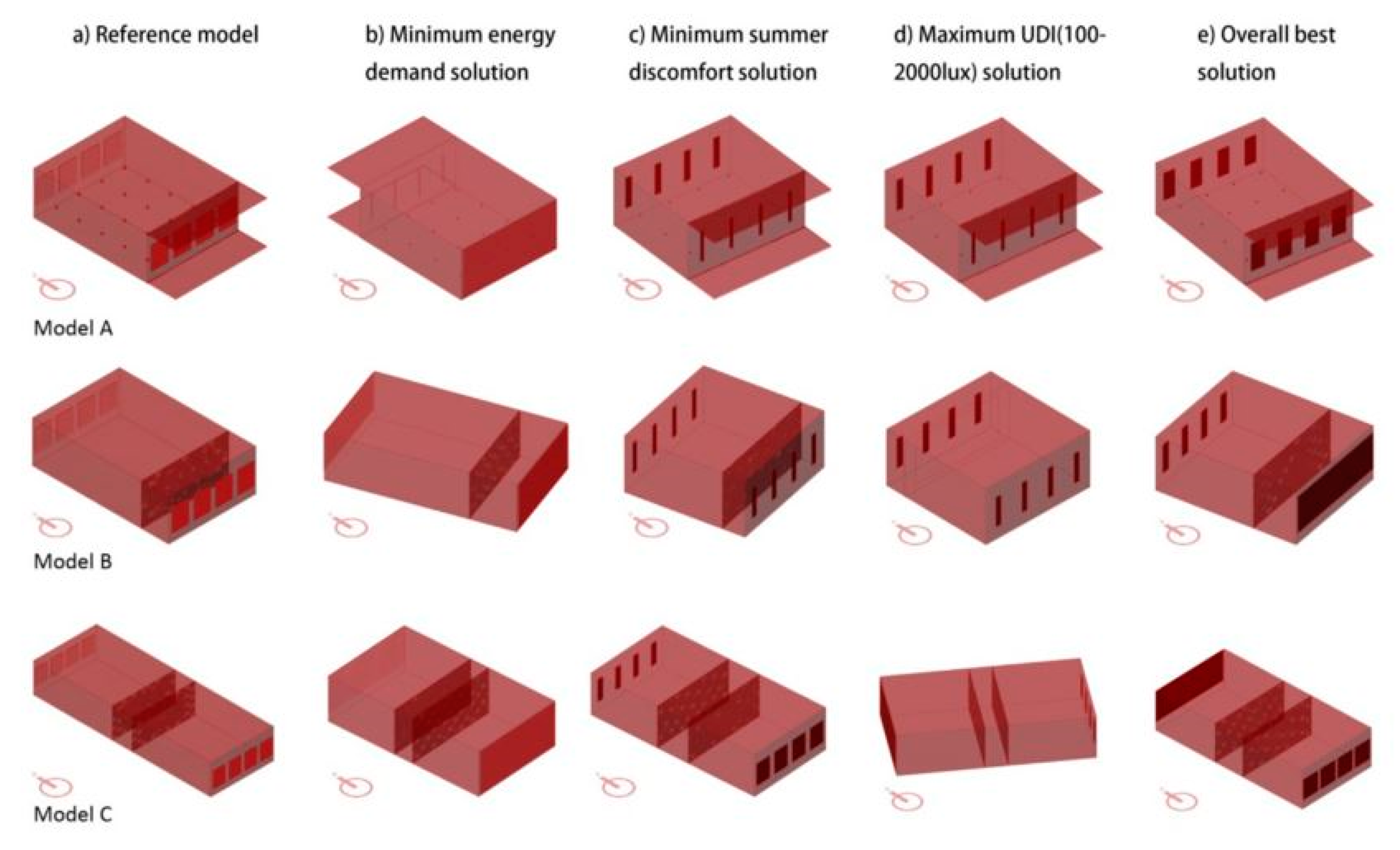

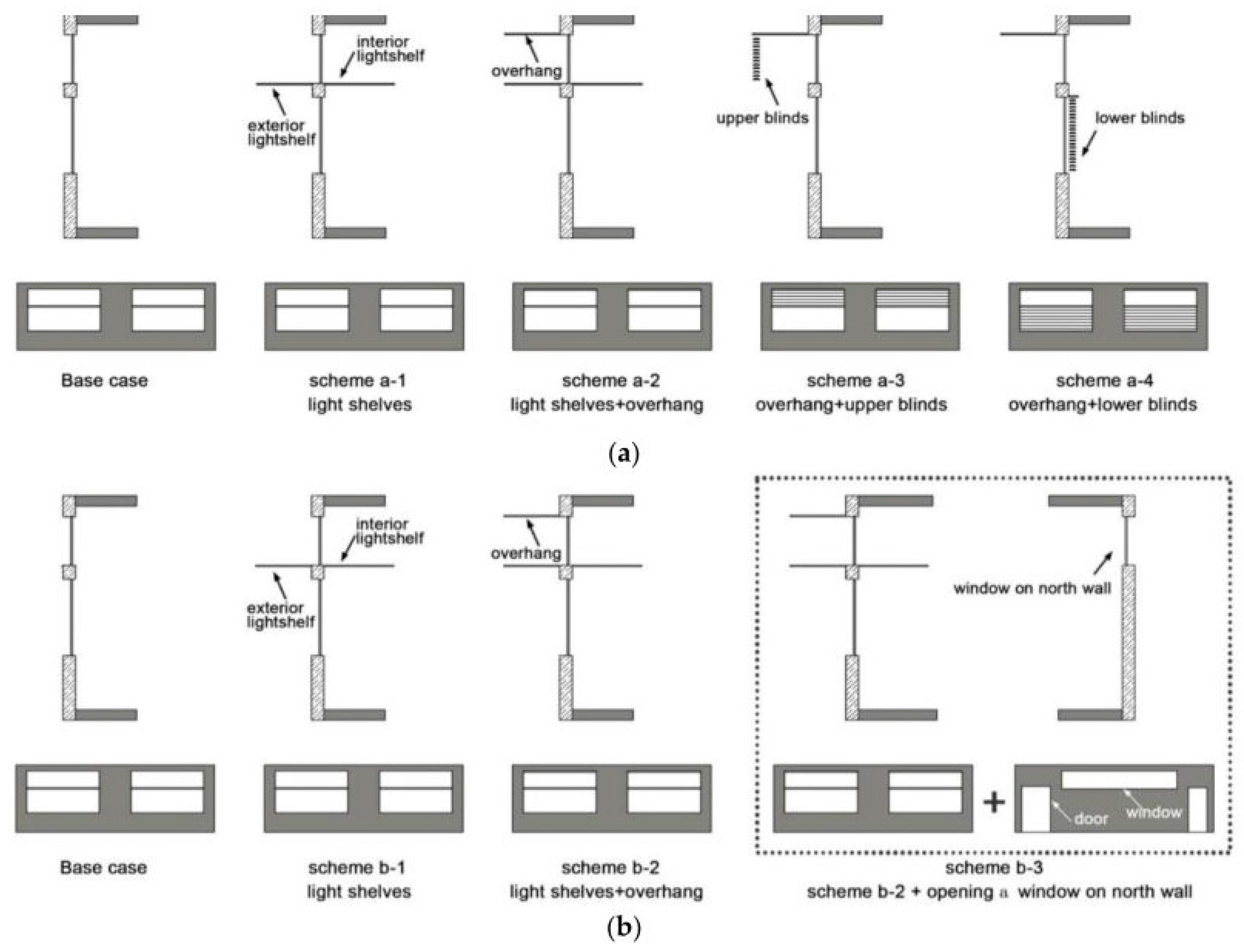
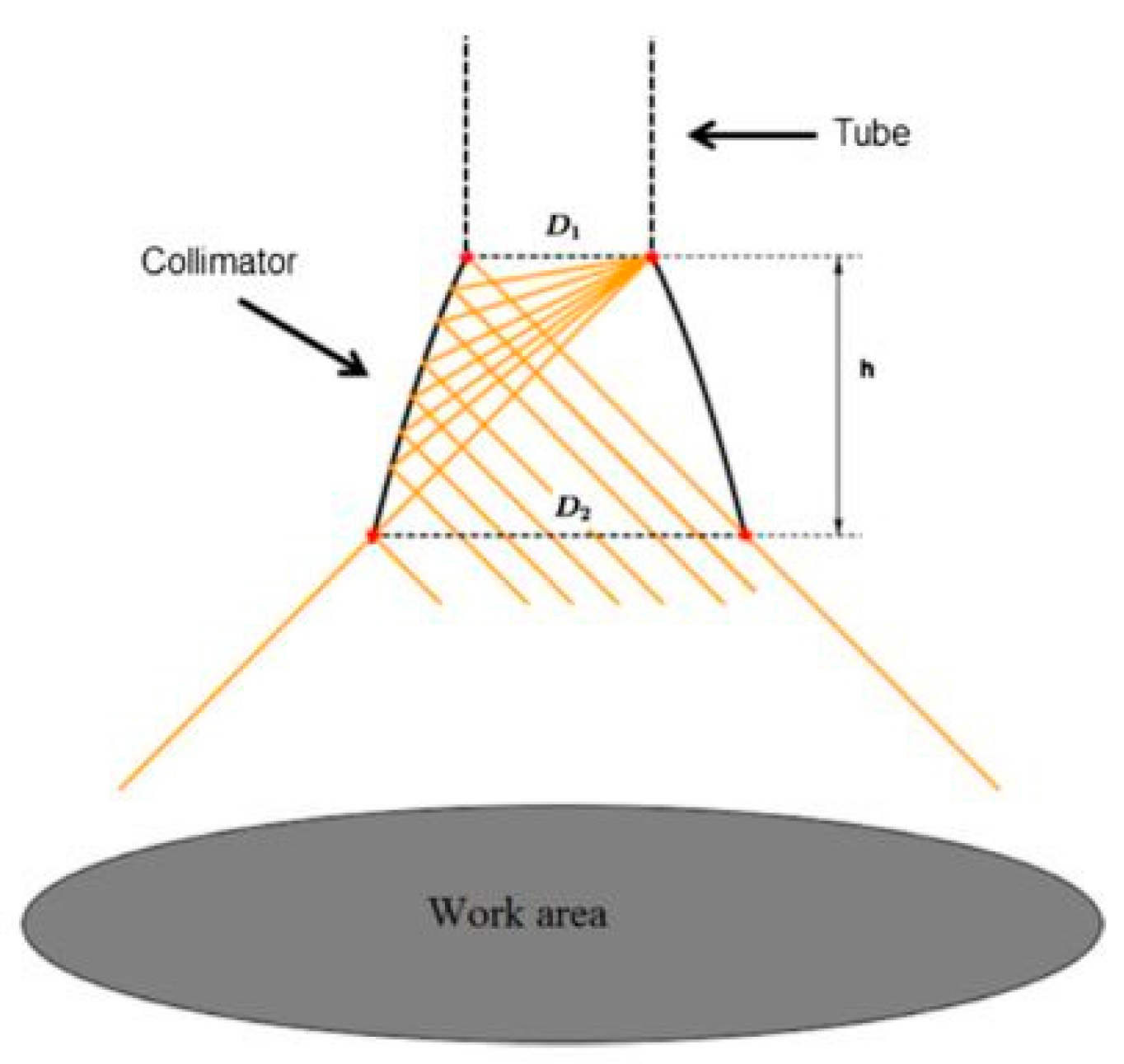
| Metrics | Symbol | References | Recommendations (Classrooms) |
|---|---|---|---|
| Illuminance based | |||
| Illuminance | E | [14,22,23,24,25,26,27,28,29,30,31,32,33,34,35,36,37] | Em > 300 lux [10,60,61] Em > 300 lux for at least 2000 h [62] 300 < Em < 3000 on at least 90% of the floor area [63] * |
| Uniformity Ratio | U | [14,24,27,29,37,38,39] | U > 0.6 on the task area [10,61] ** U > 0.4 in the surroundings [10,61] U > 0.3 (U > 0.7 with glazed roofs) [62] |
| Daylight Factor | DF | [26,29,32,34,37,38,40,41,42,43,44,45,46,47,48] | DFavg > 3% ∩ DFmin/DFmax > 0.16 [60] DFavg > 5% ∩ DFmin > 2% [10] *** DF > 2% on at least 80% of the room [62] |
| Useful Daylight Illuminance | UDI | [14,31,32,38,46,49,50,51] | --- |
| Daylight Autonomy | DA | [30,31,32,38,51,52,53] | --- |
| Spatial Daylight Autonomy | sDA | [14,46,51,54,55,56] | Preferred: sDA300/50% > 75% on occupied area [63,16] Acceptable: sDA300/50% > 55% on occupied area [63,16] |
| Annual Sunlight Exposure | ASE | [54,55] | Preferred: ASE1000/250h < 3% on occupied area [16] Acceptable: ASE1000/250h < 7% on occupied area [16] Sufficient: ASE1000/250h < 10% on occupied area [63,16] |
| % adequate workplace | --- | [35,57] | --- |
| Luminance based | |||
| Luminance | L | [36,56,58] | Acceptable glare: L < 2000 cd/m2 [17] Intolerable glare: L > 6000 cd/m2 [17] |
| Discomfort Glare Probability | DGP | [29,38,55,56] | Imperceptible glare: DGP ≤ 0.35 for 95% of time [19] Perceptible glare: DGP ≤ 0.40 for 95% of time [19] Disturbing glare: DGP ≤ 0.45 for 95% of time [19] |
| Spatial Visual Discomfort | SVD | [20] | SVD0.45–20% < 10% [20] |
| Spatial Contrast, Annual Spatial Contrast, Annual Luminance Variability | --- | [21] | --- |
| Other metrics | |||
| Circadian metrics | --- | [23,30,59] | --- |
| Design Solution | References | Remarks |
|---|---|---|
| Classroom layout and window’s properties | ||
| Room orientation and layout; Inner surfaces reflectance; Windows geometry and size; Glazing optical properties | [20,24,26,31,37,39,41,44,47,49,51,52,64] | Several combinations are analysed in order to maximize daylight harvesting and distribution in the rooms. Sometimes, the daylighting analysis is coupled with a thermal analysis assessing overheating risks and/or the energy demand for space heating and cooling, as well as the artificial lighting system energy demand. Need to carefully consider the influence of the surrounding environment. |
| Laser cut panels | [29] | Ability to deflect upwards most of the sunlight while transmitting the diffuse component |
| Internal blinds | [36,38,46,51] | Movable semi-transparent fabric panels or rolls reduce glare issues if coupled with external shading devices designed according to the room’s orientation |
| External shading devices | ||
| Overhangs | [34,47,49,50,57] | Well suited for south-oriented rooms, often necessary to avoid overheating in the summer at low latitude climates |
| Louvers | [20,31,34,38,39,46,51] | Well suited for east and west orientations, fixed devices often require additional internal blinds and work better under clear sky conditions |
| Solar screens | [55] | Downward tilt angles and 1:1 louvers depth ratio are optimal solutions for achieving good spatial daylight availability without the risk of glare |
| Movable blinds | [42] | External semi-transparent blinds, together with light shelves, improve illuminance uniformity |
| Re-directing systems | ||
| Light shelves | [27,28,31,37,42,45,47,50] | If coupled with clerestory windows, they are expected to increase the DF in the room as well as its uniformity under sunny sky conditions. Under different operational conditions, poor performance is usually achieved |
| Light pipes | [25] | A light reflector in the collecting dome can increase illuminance on cloudy days up to 30% |
| Control systems | ||
| Artificial lighting dimming controls | [33,65,66,67,68,69] | Control logics are usually too simplistic to guarantee both visual comfort conditions and energy savings due to reduced artificial lights use |
© 2017 by the authors. Licensee MDPI, Basel, Switzerland. This article is an open access article distributed under the terms and conditions of the Creative Commons Attribution (CC BY) license (http://creativecommons.org/licenses/by/4.0/).
Share and Cite
Costanzo, V.; Evola, G.; Marletta, L. A Review of Daylighting Strategies in Schools: State of the Art and Expected Future Trends. Buildings 2017, 7, 41. https://doi.org/10.3390/buildings7020041
Costanzo V, Evola G, Marletta L. A Review of Daylighting Strategies in Schools: State of the Art and Expected Future Trends. Buildings. 2017; 7(2):41. https://doi.org/10.3390/buildings7020041
Chicago/Turabian StyleCostanzo, Vincenzo, Gianpiero Evola, and Luigi Marletta. 2017. "A Review of Daylighting Strategies in Schools: State of the Art and Expected Future Trends" Buildings 7, no. 2: 41. https://doi.org/10.3390/buildings7020041






